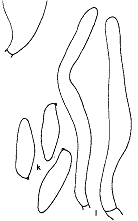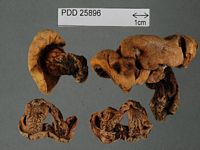|
 Boletus novae-zelandiae Boletus novae-zelandiae
BiostatusPresent in region - Indigenous. Endemic
Images (click to enlarge)
Caption: B. novae-zelandiae: k, spores; I, cystidia. | 
Caption: Dried type specimen.
Owner: Herb PDD |
Article: McNabb, R.F.R. (1968). The Boletaceae of New Zealand. New Zealand Journal of Botany 6(2): 137-176 (http://www.rsnz.org/publish/abstracts.php).
Description: PILEUS: convex
when young, plano-convex at maturity, 3.5-6.5 cm diam., dry, finely felted to
subtomentose when young, subglabrous at maturity, dull yellow; cuticle a poorly organised trichodermium when young. Becoming disorganised at
maturity and composed of interwoven, thin-walled, smooth or slightly roughened,
septate hyphae 3.5-8 µm. diam., terminal cells repent or obliquely ascending,
not inflated; margin entire, extending beyond pores, sterile. HYMENOPHORE: tubes
to 6 mm long, adnate, yellow to bright golden yellow; pores concolorous with
tubes, irregularly angular, 1-1.5 mm diam.; unchanging where damaged. STIPE:
2.5-3.5 cm long, more or less equal, 1.2-1.8 cm diam., solid, dry, subglabrous
to finely subvelutinate from a close palisade of caulocystidia, yellow to sordid
yellow, annulus absent.
SPORES: spore print
not obtained; spores melleous, elliptic-subfusiform, 14.2-18.2 X 4.5-5.5 µm,
smooth. HYMENIUM: basidia hyaline, clavate, 26-36 X 8.5-10.5 µm, 4-spored; cystidia
scattered, hyaline, thin-walled, subcylindrical to cylindrical, 36-55 X 4.5-6.5
µm.. HYMENOPHORAL TRAMA: bilateral of the Boletus subtype; clamp connections
absent. CONTEXT OF PILEUS: yellow, unchanging or becoming faintly red on exposure
to air. SMELL: not distinctive.
Habitat: HABITAT: Gregarious under Leptospermum.
Notes: Boletus novae-zelandiae belongs in sect. Subpruinosi (Singer, 1947) and is
closely related to B. rawlingsii. It may be distinguished from the latter
by the longer, elliptic-subfusiform spores and narrow, more or less cylindrical
cystidia.
|